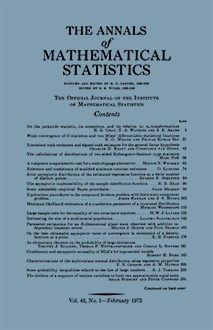Abstract
The problem of constructing tolerance limits for a normal universe is considered. The tolerance limits are required to be such that the probability is equal to a preassigned value $\beta$ that the tolerance limits include at least a given proportion $\gamma$ of the population. A good approximation to such tolerance limits can be obtained as follows: Let $\bar x$ denote the sample mean and $s^2$ the sample estimate of the variance. Then the approximate tolerance limits are given by $\bar x - \sqrt\frac{n}{\chi^2_{n,\beta}} rs \text{and} \bar x + \sqrt\frac{n}{\chi^2_{n,\beta}} rs$ where $n$ is one less than the number $N$ of observations, $\chi^2_{n,\beta}$ denotes the number for which the probability that $\chi^2$ with $n$ degrees of freedom will exceed this number is $\beta$, and $r$ is the root of the equation $\frac{1}{\sqrt{2\pi}} \int^{1/\sqrt{N} + r}_{1/\sqrt{N}-r} e^{-t^2/2} dt = \gamma.$ The number $\chi^2_{n,\beta}$ can be obtained from a table of the $\chi^2$ distribution and $r$ can be determined with the help of a table of the normal distribution.
Citation
A. Wald. J. Wolfowitz. "Tolerance Limits for a Normal Distribution." Ann. Math. Statist. 17 (2) 208 - 215, June, 1946. https://doi.org/10.1214/aoms/1177730981
Information





